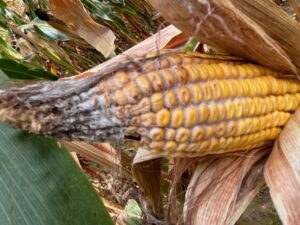Field Observations
SPRING 2024

June 13, 2024
This spring is starting to sound like “the song that never ends.” If you can remember it from childhood, it’s a song that just goes on and on and never ends. While some areas have crops that are progressing well, other areas still have significant acreage to be planted. Fields that have been planted seem to be progressing well, with corn staging up to V7 and soybeans V4, while winter wheat is in the flowering to milk stage.
Corn
With roughly 90 percent of the corn crop planted, the remaining acres will soon be switched to soybeans if they haven’t already. Those who have livestock and need corn for feed will be changing hybrids to account for the later planting. The Agricorp corn planting deadline for crop production insurance is June 15. Initial and replanted acres must be planted before the deadline to be insured. Replanted acres planted after the deadline will need to be kept separate at harvest; call Agricorp for more details.
The growth stage for much of the crop is between 3 to 8 leaves (V2 to V7 collar). During these stages, the corn plant has been developing nodal roots under ideal conditions. Before nodal roots are developed, the plant depends on the support from the seminal roots and kernel. Uneven plant development in the field at this stage could be caused by damage to the seed kernel reserve and seminal roots. Things that might cause stress to the young corn plant’s root development are salt injury from fertilizer, herbicide injury, seedling disease, insect feeding, compaction, and very wet or dry soils. Ideally, nodal roots will tap into the starter fertilizer band and use that nutrition for optimum development. They will begin growing rapidly in the coming weeks.
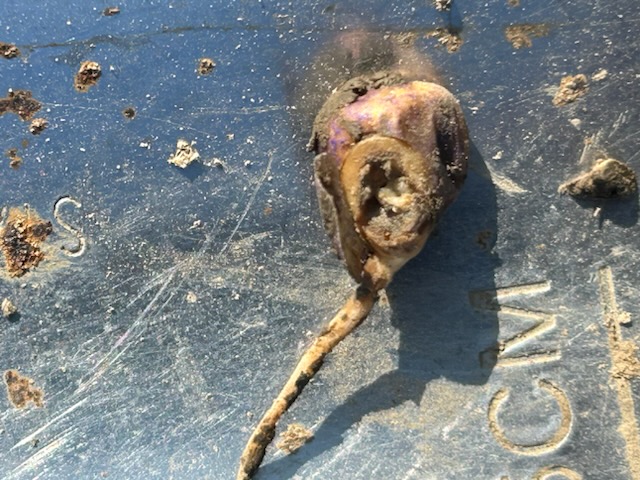
Weed control has been challenging this year due to wet ground and high winds. Timely weed control is critical for top yields. As shared in last week’s write-up, there is a significant loss in both bushels and dollars due to a delay in herbicide application during the critical weed-free period.
Corn rootworm trap network participants are needed to help trap and count corn rootworm (CRW). The traps are free (funded by Grain Farmers of Ontario), and trapping will begin in July. Data is entered weekly and helps monitor for Bt-resistant populations and to scout the corn crop. It is anticipated that higher levels of CRW will be seen this year due to the mild winter and warm spring. More info on CRW and insect resistance can be found in this Grain Farmers of Ontario Corn rootworm Agronomy Alert.
Soybeans
Soybean planting provincewide is 80 per cent complete, with a number of regions that still need to plant. Soybean stage is anywhere from just planted all the way up to the fourth trifoliate (V4). There are still lots of soybeans to go into the ground in areas that have received excessive and continual rains. Now is a good time to check plant populations. Soybeans can compensate for lower stands (i.e. 90,000/acre on a loam, 110,000/acre in clay); however, the late calendar date may impact some management decisions this year.
There have been some replant decisions made this year due to heavy rains causing crusting, poor emergence, and slug damage. There has been some bean leaf beetle pressure on emerged fields. This is a good reminder that rotating crops is important, as many are showing up in second-year soybeans. Cutworm and wireworm are causing damage and lowering plant populations in some areas, causing replants in some fields. Be sure to scout and do stand counts (counting only the healthy plants) while assessing the size of the pest to determine if corrective action will need to be taken (if the pest is too large, it will be hard to control).
There have been some discussions on switching to shorter season varieties, seeding rates and the effects on yield as planting moves further into June. There is a great article recently posted on Field Crop News that can help address these questions; overall, increasing seeding rate is advised as the month progresses, but if the plan is to get wheat in the ground in a timely manner, then a change might be warranted. However, planting an early maturing variety late in the season will produce a short plant, with not many pods impacting potential yield.
Many regions are having a hard time getting timely weed control completed. Soybean and corn herbicide applications have been happening simultaneously while planting, rain delays and high winds have hampered spray opportunities.
Some soybeans are showing injury from metribuzin – yield loss is rare in this situation. Injury appears as crinkling of unifoliate and/or trifoliate leaves depending on when uptake occurs. Injury is often due to heavy rains falling after application, activating the herbicide. Sandy soils and fields with low organic matter would be the areas that could really show injury. Different varieties will show more injury, as will be cultivated over no-till.
When applying herbicides, fungicides, and insecticides, always aim for best practices and rotate active ingredients, ensure that pests are at threshold and ensure other key elements are to lower the chance of resistance. Manage Resistance Now is a fantastic resource on herbicide, fungicide, insecticide resistance, and IPM practices to avoid resistance.
Cereals
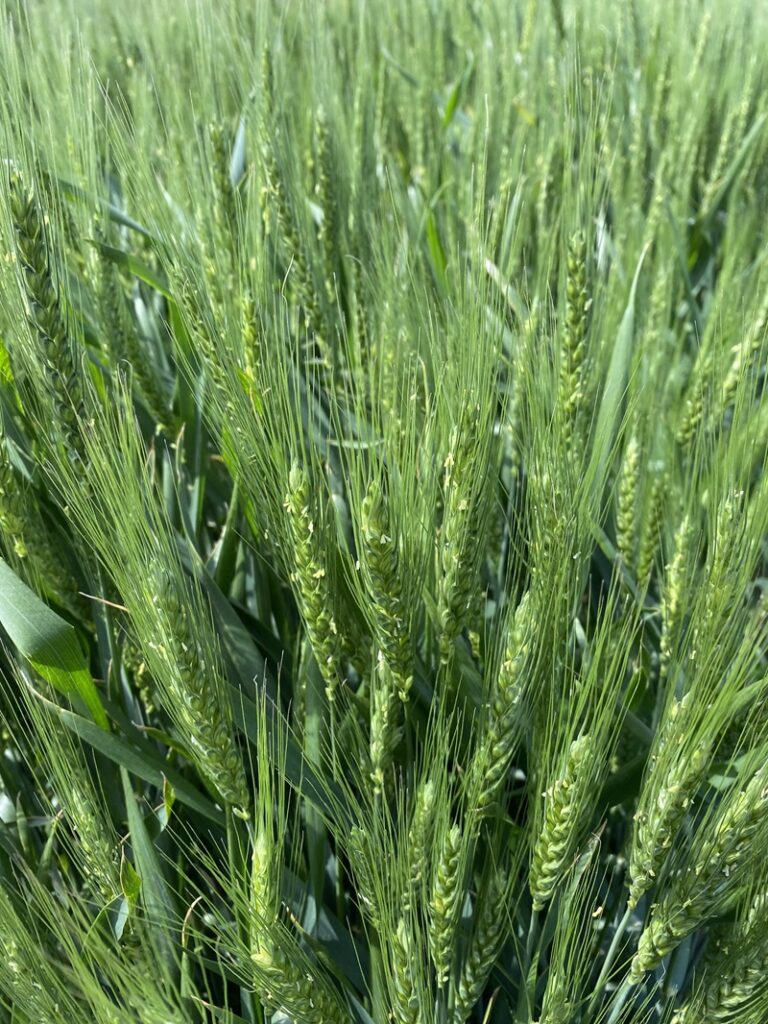
Winter wheat is staging from flowering to milk stage (GS 63, flowering ¼ complete to GS 77, late milk). T3 fungicide timing (during flowering) is still occurring across the province. With the weather being cooler, damp, and rainy in recent days, it is a prime setup for fusarium head blight. As harvest nears, be sure to scout for the disease and harvest appropriately (make sure combine settings are correct). The cooler weather is also a bonus for grain fill; the longer the grain fill period, the better the chance for higher yields, but as is known, things can change, and change quickly, as 30-degree days are on the way next week, which will increase the rate of grain fill.
Stripe rust is still showing up in some cases on susceptible varieties after T3 applications, so be sure to scout and make a note of which varieties are highly susceptible and use those notes to help choose varieties next year.
Be on the lookout for armyworm (some fields have met threshold, with spraying occurring) and cereal leaf beetles in cereal fields. More info on both pests can be found here.
Spring cereals are in the tillering to stem elongation growth stages.
Mental Health
It has been a rough spring, and though many have been through years like this over their career, many have not. It is not any easier for one person than it is for another. There are several support resources available if you need to speak with someone. And, sometimes, reaching out to a neighbour or farming friend and having a chat might be the best part of their day (and yours); we are all in this together.
June 6, 2024
It certainly is nice to see the fields with emerged plants and developing after many weeks of waiting to be planted. Soybean planting is still progressing, while many winter wheat fields are in the flowering to the beginning of grain fill stages.
Corn

The last few remaining acres were planted in southern Ontario’s recent “dryish” spell. Most of the corn is staging from emergence to 5 leaf stage (VE to V4). Weed control at this time is critical as this is the weed-free period of the crop’s life; any competition will influence crop yield. Post-emergent herbicides that were to be applied may have delayed application due to rain events. Research by Peter Sikkema in high-density weed environments has shown that if corn is seven days post-emergence, there will be a $28 per acre loss ($4 per day loss, with corn at $6.38/bushel), which goes up from there. Get post-emergent herbicides on as soon as possible to minimize the losses.
The next operation in many of these corn fields will be side dressing of nitrogen (N). Those with little to no nitrogen applied will look at side dressing in the next couple of weeks, while those with N applied with starter or preplant will apply a few weeks later when the crop has a higher demand for nitrogen. At the V3 stage, the kernel reserves are starting to dwindle, and the corn seedling will need to switch over to relying on the nutrients delivered through the nodal roots. Any delay in the switch to root feeding can impact the plant’s growth.
Any further fields that were slated for corn are now close to or already have been pivoted to plant soybeans, especially if the field is not drying up.
The next Agricorp planting deadline is June 10 for area D.
Soybeans
Much of the province remains wet, with sporadic amounts of planting when ground is fit. However, planting is nearing completion, with some areas wrapped up and others less than 50 per cent complete. An estimated 60 to 80 per cent of the acres are planted at this time, with a few more acres left to wrap up seeding for the year, with an understanding that some clay fields have yet to see a planter.

Fields should be checked two days after planting to see if the seed has imbibed moisture and if germination has begun (imbibing moisture should not be a problem in most of the province this year). There have been some concerns about crusting, but with luck, the recent rains will allow soybeans that were knuckling and pushing against crusted soil to emerge. Soybeans are staging from emergence (VE) to first trifoliate (V1).
There have been some discussions on switching to shorter season varieties, seeding rates, and effects on yield as planting moves into June. There is a great article that has been recently posted on Field Crop News that can help address these questions.
Be on the lookout for root rots, as many roots are sitting in saturated soils. Phytophthora root rot and Pythium seedling and root rot could be seen in fields.
Cereals
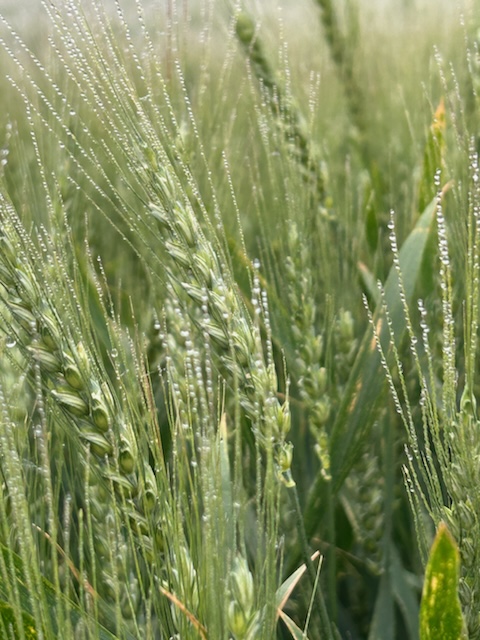
Winter wheat across most of the province has heads emerged (GS 59) to milk stage (GS71, kernel watery ripe). T3 applications continue as fields reach the spray window. Grain fill in cooler weather is ideal as it will allow for a long grain fill period, allowing for top yields. During the milk stage, kernel length is established.
Insect pressure continues across the province in winter wheat. Armyworm and cereal leaf beetle seem to be the main concerns this year. For the best economic impact, ensure you have reached the insect population threshold before pulling the trigger on spraying for control. Check with your pesticide supplier on product availability and recommendations, as selected products will be in tight supply. Read more in the latest Scouting Alert update from Tracey Baute in Field Crop News.
Mental Health
This year has been a rough spring, and though many have been through years like this over their career, many new farmers have not. It is not any easier for one person than it is for another. There are several support resources available if you need to speak with someone.
May 30, 2024
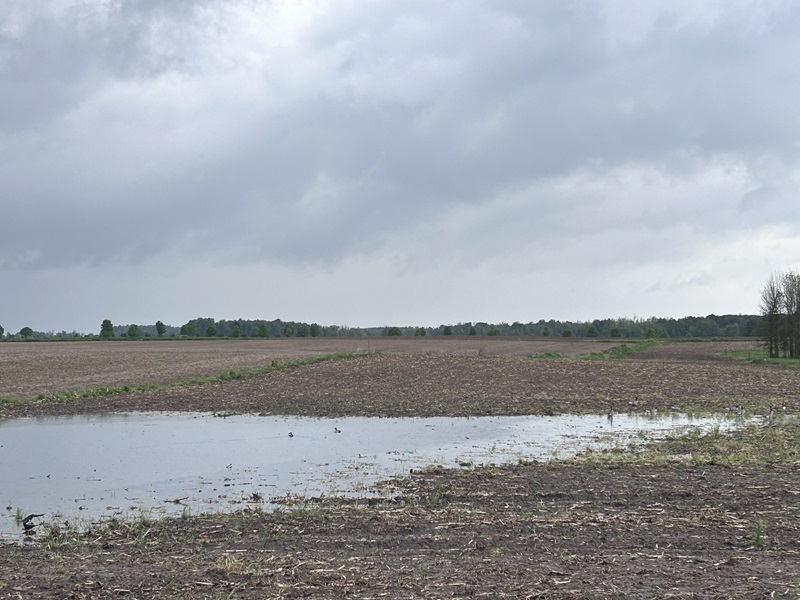
The story of the season has been rain followed by more rain, halting planting progress as farmers wait for fields to dry out. As the calendar moves forward this weekend, there is a lot of hope that the weather will sort out quickly and allow planting to continue. Let’s take a look at planting progress and crop stages across Ontario.
Corn
Planting progress has slowed this week with rain delays. Sixty to 95 per cent of corn acres have been planted, with some farmers finished and some just starting. With the warm temperatures, some areas have seen corn emerge within seven days. Fields planted in loose, finely textured seedbeds and have received heavy rains after seeding should be monitored for crusting. Breaking the crust will allow seedlings to emerge and prevent leafing out underground, causing a reduction in plant stands.
Corn staging across the province is from just emerging (VE) to the 3-leaf (V2) stage. At this point, some areas of the province are switching the remaining corn acres to soybean acres as the calendar flips to another month. Some thoughts for the deep southwest portion of the province is that if it is possible to find a good yielding, short-day corn hybrid and keep a long-term rotation, it is worth entertaining to stay the course of corn for now. However, areas that receive less heat units should consider that there just might not be enough CHUs to finish the corn when planting at this time of the year and allow for low moisture and high-test weights, and good yield at harvest.
Soybeans

Soybean planting is underway, with 25 to 40 per cent complete (with some areas with heavy soil yet to begin planting). Yield for corn or soybeans is determined not just by the calendar but also by the seedbed conditions. Pushing planting in unfit conditions sets the crop up for early stress and limits root development, preventing moisture and nutrient uptake by the plant.
There have been some discussions on switching to shorter season varieties, seeding rates and effects on yield as planting moves into June. There is a great article that has been recently posted on Field Crop News that can help address these questions.
Soybeans planted into ideal conditions earlier this month are emerged (VE) to cotyledons stage (VC).
As plants emerge, it is a great time to assess plant stands. Poor stands can be caused by seed rots, herbicide injury, insect issues, and planter issues (seed depth, compaction, etc.) A common way to do soybean stand counts is to use a hula hoop. For example, toss a hula hoop that is 32 inches in diameter randomly in the field. Count the emerged plants and multiply by 7800 to get the estimated plants per acre.
Soybeans need a lot of push to emerge. If there are some concerning fields, check stand counts by taking physical counts and evaluate the stands for uniformity. This chart can help estimate your final yield potential based on uniform stands depending on your conditions.
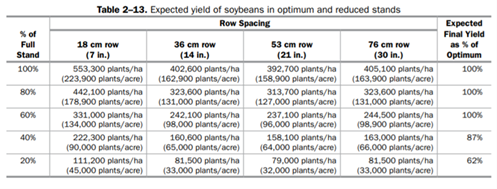
SOURCE: AGRONOMY GUIDE FOR FIELD CROPS, PUB 811.
Be on the lookout for root rots, as many roots are sitting in saturated soils. Phytophthora root rot and Pythium seedling and root rot could be seen in fields.
Don’t be caught off guard for pre-emerge herbicide applications, as soybeans are up and growing and therefore limit which herbicides might be sprayed. Speak with your agronomist for other options if soybeans are close to emerging. A good rule of thumb after applying a pre-emerge is to set a calendar reminder for seven, 14, and 21 days after application to go and scout fields to see if the pre-emerge worked or if a rescue treatment is needed.
Cereals
Oat, barley, and spring wheat planting is just about wrapped up in many regions. Northern Ontario still has some planting but is limited by the weather as some areas are affected by the spring rains.
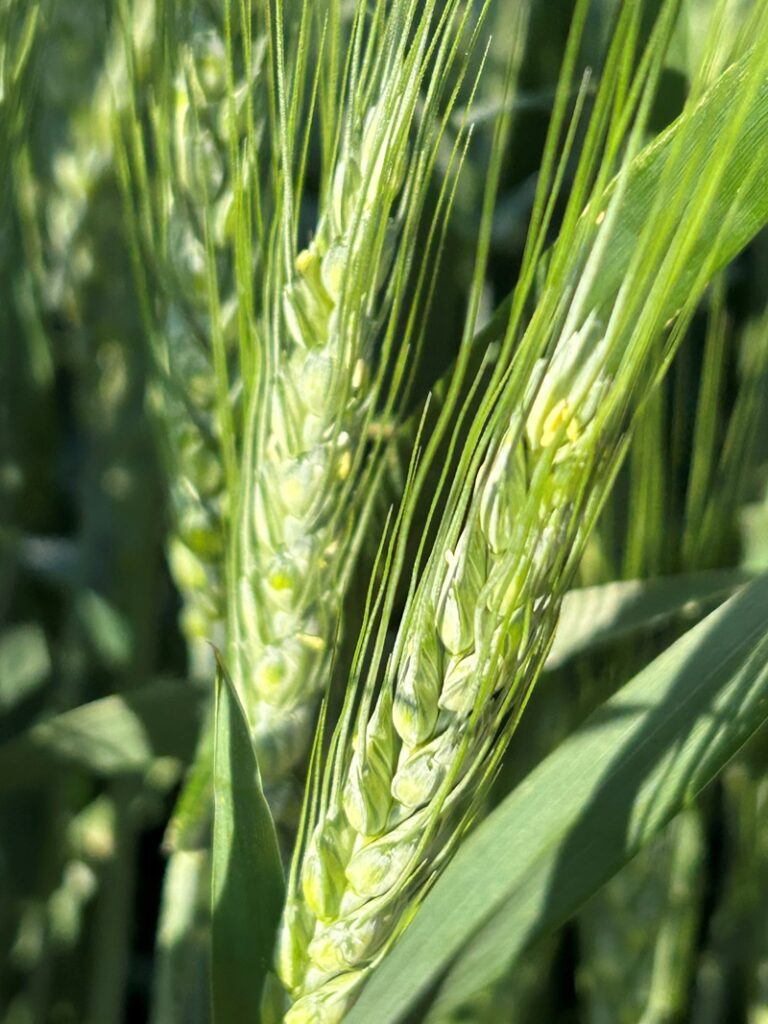
Winter wheat is still progressing ahead of normal in most areas. In the deep southwest, wheat has finished pollination (GS 69) in some cases, while other areas of the province are staging in the boot stage with the flag leaf sheath opening (GS47). T3 applications are ongoing where flowering is occurring (as field conditions allow). Some lodged wheat has been seen after pounding rains. This year, lodged wheat could be common due to rapid growth through the stem elongation stage.
Stripe rust has crossed the border into Ontario and is being identified in fields across southern Ontario. Stripe rust can be identified by small chlorotic lesions that have yellow/light orange pustules that emerge from the lesions. The pustules develop parallel to leaf veins, giving the wheat a “striped” appearance. Winter wheat is staging across the province from stem elongation (GS 32, 2nd node detectable) to GS 61 (beginning of flowers). Left unchecked, stripe rust can cause significant yield reductions. Within Ontario wheat varieties, there are sizeable variety differences in susceptibility. Investigate whether your wheat has a high or low susceptibility by contacting the seed supplier or checking the provincial ratings at GoCrops.ca. Continue to scout for this disease now that it has been found in the province, as it will help determine when a fungicide application is required. There are some variables for when spraying should occur, depending on the growth stage and infection of the disease; read more in this Field Crop News article, Effectively Managing Stripe Rust.
Spray tank cleanout
With fungicide applications imminent or occurring, it is essential for a good tank cleanout before fungicide application. Getting the previous product out of the tank as soon as possible after spraying, the rinse process and proper draining are all part of the process. More can be found on proper cleanouts at Sprayers101. A reminder to wear proper PPE while performing a cleanout (and any other time handling or close to chemicals).
Managing off-target pesticide movement
The sprayers are running, and acres are being covered. Do you know how to mitigate drift? Join Dr. Jason Deveau (AKA Spray Guy) as he shares valuable insights on off-target pesticide movement, strategies to limit movement, temperature inversions and more in the Grain Farmers of Ontario GrainTalk Webinar on drift management. CCA CEUs are available. For more information on drift, you can also visit the BeDriftAware.ca site.
May 23, 2024
This past week, there was planting progress across the province, with sunny skies leading up to and into the long weekend. However, on Monday night, some areas saw light rains, while others saw up to three inches of rain, bringing a lot of areas that were ‘just’ about dry enough to be planted to another grinding halt. Advanced winter wheat is flowering (be on the lookout for stripe rust), while planted corn and soybeans are germinated and emerging.
Corn
The past few days have been good for corn planting (before Monday’s rains). It is estimated that corn planting is hovering around 50 to 70 percent complete (however, we realize that some areas have still yet to plant due to ongoing wet soils).
Keep an eye out for soil crusting; with various planting dates, soil textures, and weather patterns, some fields may have crusting issues and need some assistance to help the corn plants emerge.
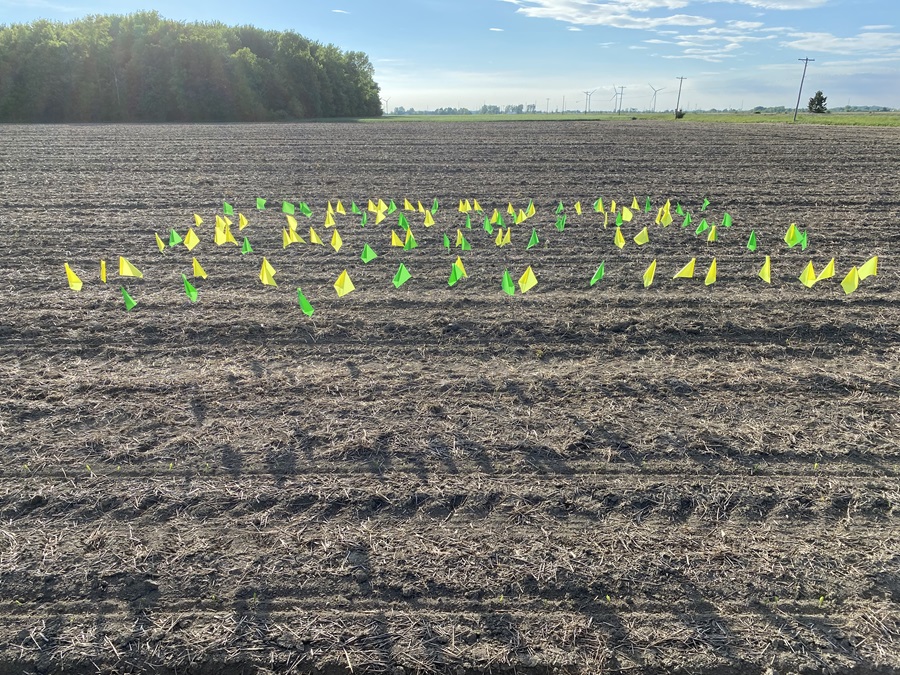
As corn emerges, it is a good time to do stand counts. Using a tape measure on 30-inch rows, measure a length of 17 feet, five inches. Count how many plants have emerged. Multiply the number of plants in the measured area by 1000, giving you the final plant stand.
Many things can affect plant stands. Planting into cold, wet conditions can cause delayed emergence and reduce plant populations due to seedling rots, insect feeding and seedbed compaction. A planter set up with too much down pressure on the closing wheels can make the seedling work hard at emergence and cause the seedling to leaf out underground, emerge late, and look like a corkscrew. Heavy rains after planting can compact the soil and make it difficult for the plant to emerge. Adjusting the planter to the conditions of each field is important to maximize emergence.

There can be emergence variability across a field. Many different things could create emergence concerns, including moisture, temperature, soil structure, etc., and insects feeding in a grassier area or edges of the field. A variety change could also be considered in future years if it is not area-specific.
When looking at crop heat units (CHU) for Elora from May 14 to May 21 this year, the area received 132 CHUS; in the same period historically (54 years), only 101 CHUs were received. The fields that have been planted have received a good bit of CHUs from the heat experienced this long weekend.
In shorter growing season area’s of the province, it’s now time to consider a hybrid switch from full season to shorter season.
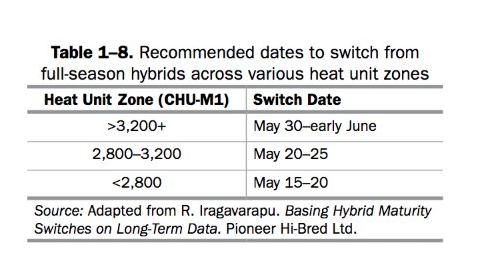
For further information, visit Field Crop News.
As the end of May draws near, it is important to keep Agricorp spring planting deadlines in mind, as some areas have a May 31 deadline (area E).
Soybeans
Soybean planting also had a good run; however, no-till ground was still found to be a bit too wet in several areas. It is estimated that planting progress for soybeans is around the 0 to 30 percent mark.
For those areas that have planted and then did get a hard, pounding rain, similar to corn, keep an eye out for crusted soils and be prepared to take remedial action if needed to help get those soybeans out of the ground.
Cereals
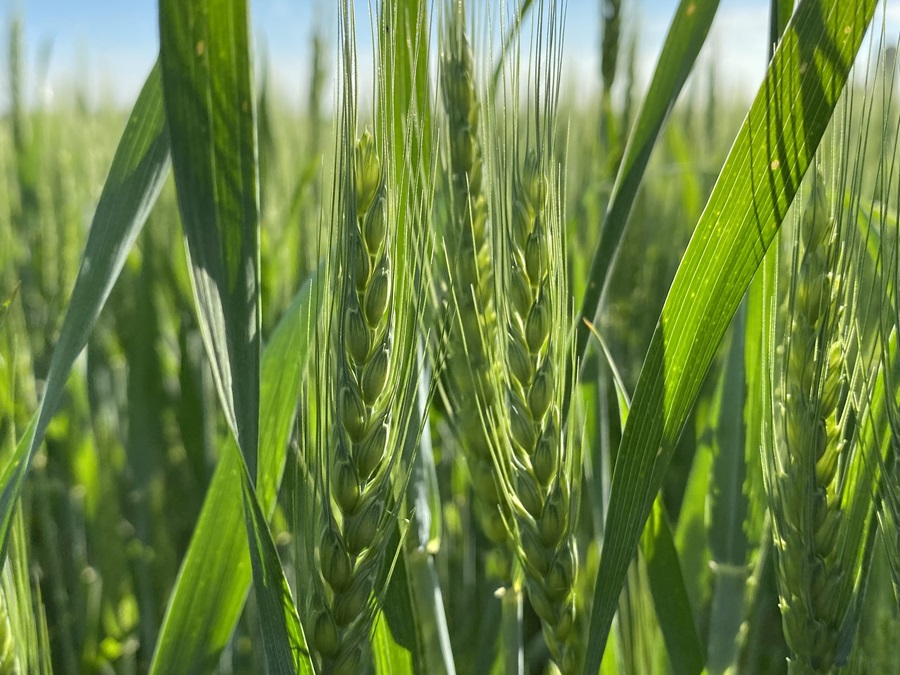
Spring cereals have emerged and are in the seedling growth stage (GS 10 to GS 14).
Stripe Rust has crossed the border into Ontario and is being identified in fields across Southern Ontario. Stripe rust can be identified by small chlorotic lesions that have yellow/light orange pustules that emerge from the lesions. The pustules develop parallel to leaf veins, giving the wheat a “striped” appearance. Winter wheat is staging across the province from stem elongation (GS 32, 2nd node detectable) to GS 61 (beginning of flowers). Left unchecked, stripe rust can cause significant yield reductions. Within Ontario wheat varieties, there are sizeable variety differences in susceptibility. Investigate whether your wheat has a high or low susceptibility by contacting the seed supplier or checking the provincial ratings at GoCrops.ca. Continue to scout for this disease now that it has been found in the province, as it will help determine when a fungicide application is required. There are some variables for when spraying should occur, depending on the growth stage and infection of the disease; read more in this Field Crop News article, Effectively Managing Stripe Rust.
Spray tank cleanout
With fungicide applications imminent or occurring, it is essential for a good tank cleanout before applying fungicide. Getting the previous product out of the tank as soon as possible after spraying, the rinse process, and proper draining are all part of the process. More can be found on proper cleanouts at Sprayers101. Remember to wear proper PPE while performing a cleanout (and any other time handling or close to chemicals).
May 16, 2024
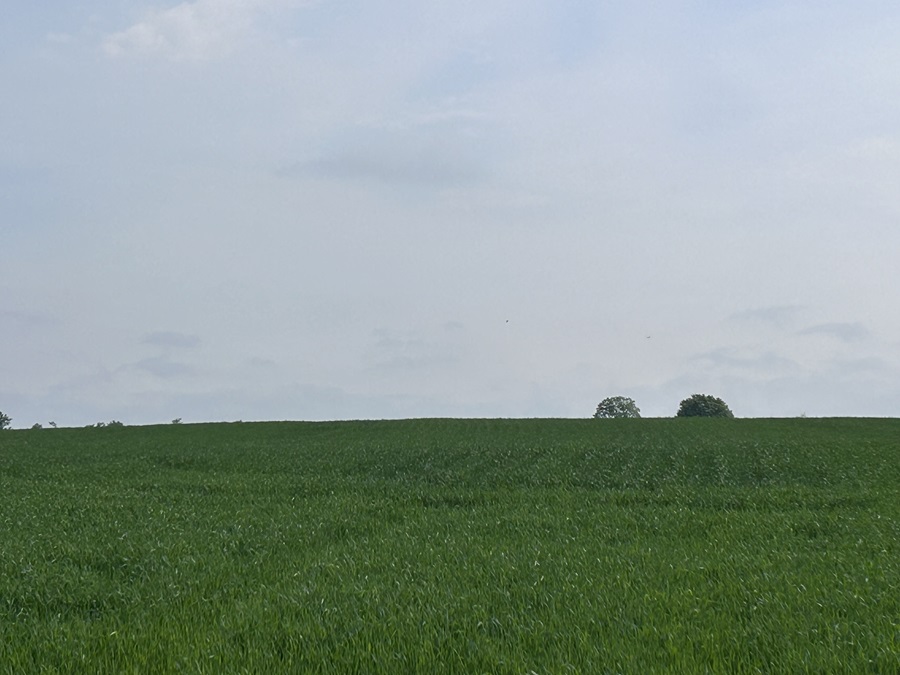
Planting progress has been sporadic throughout much of Ontario this past week, with some areas still experiencing delays due to wet fields and others seeing some movement of planters and drills. Fields planted in corn will see corn germinating and emerging in the next few days, likewise for soybeans. Winter wheat is beginning to head in some areas and boot stage in others.
Corn
Where ground has been fit, corn has gone in the ground, roughly five to 30 per cent of planting progress province-wide. Corn planted in late April has emerged.
Herbicide and nitrogen applications will be going on planted corn ground as they can.
With warm weather, corn heat units (CHU) are accumulating quickly, and corn seeds will germinate and emerge. If planted this week with maximum CHU accumulation (30 per day), the corn could be out of the ground in five to six days, which is a lot less time for insects to be active. It is not time that gets the crop out of the ground; the heat drives the enzymatic process to get the seed to germinate, and the continued heat encourages cell growth of the developing plant seedling.
For best corn yields, U.S. corn specialists say that if the crop emerges uniformly within a 12 growing degree day (GDD) (~20 CHU window), you can maximize the crop by having a picket fence stand. A great way to evaluate your emergence timing is to use the flag method – planting flags beside the plant as it emerges. Start by measuring 1/1,000 of an acre; that way, you are also doing a population count at the same time. On the first day you can see corn spiking through the ground, place a small flag beside all the emerged plants. Return in 20 CHUs and place a different colour flag beside the newly emerged spike for that day. Keep doing this until all the corn has emerged. Be sure to use a different colour flag on different days or label each flag with the emergence date. Also, do the flag test on each row of the planter. If you find poorer or delayed emergence on a particular row, it may be related to planter setup issues. This test is also great for evaluating different planter settings (deeper or shallower) or different attachments. Visually, the row emergence may look the same, but once you start counting the plants in 1/1,000 of a row, you will be surprised at what you learn.
As the season progresses, pay particular attention to the flagged corn plot. See if the later emerged plants are weaker and smaller. Did they pollinate later? How was the ear size or cob fill? Does emergence timing make a difference in your crop?
There have been some questions on when to switch hybrids for corn for areas dealing with wet soils. Decisions on switching hybrids will be based on individual risk tolerance and what hybrids are sitting in the shed. If you had late-maturity hybrids planned for April planting, adjusting to recommended heat units for your area is necessary to avoid potentially late-harvested corn at higher moisture levels. Moving to earlier than recommended for your area will depend on the CHU area, and for some, decisions will be made later in May towards the start of June.

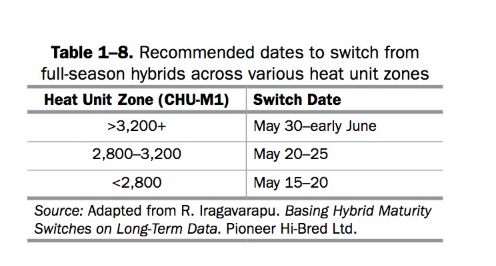
For further information and a table with recommended dates for considering a switch from full-season hybrids across various heat unit zones, visit Field Crop News.
Soybeans
Soybean planting has also begun on ground that is fit, with roughly 0 to five per cent complete.
The ideal soybean planting depth is around 1.5 to 1.75 inches, with adequate soil moisture. If soil is drying out or seedbed unevenly, seeds may need to be planted around 2- 2.25 inches if on lighter soils, but only if moisture is limited. Remember, soybean hypocotyl reach is limited and can only be extended by two-plus inches. If conditions like crusting occur, deep planted soybeans will not be able to push and extend the distance. Loose, dry soil may be the exception for the 2” plus depth. There is still lots of time to plant soybeans.
Cereals
Spring cereal fields have been planted; there are still more acres to go in the ground in Northern Ontario and other regions of the province as weather and time allow.
Winter wheat that has received a second pass of nitrogen looks spectacular in many cases. Some wheat in the deep southwest is at GS55 (half of the head is emerged), while other wheat fields to the north and east are closer to G.S. 37 to 41 (flag lead just visible to flag leaf sheath extending).
Physiological fleck has shown up in past years, when there have been many cloudy spring days, and is again showing up this year.
Fungicides are being applied to fields that are infected with powdery mildew (watch susceptible varieties). Keep in mind that strip rust could show up as it is steadily moving north through the U.S. Keep an eye out for strip rust as T3 timing approaches, as T3 fungicides help with control. The Crop Protection Hub is a great resource for what to apply for control of various weeds, diseases and insects.
Be safe!
As planting progresses, remember that safety is key. Many accidents and mistakes can occur when overtired.
Managing off-target pesticide movement
The sprayers are running; acres are being covered. Do you know how to mitigate drift? Join Dr. Jason Deveau (AKA Spray guy) as he shares valuable insights on off target pesticide movement, strategies to limit movement, temperature inversions and more in the Grain Farmers of Ontario GrainTalk Webinar on drift management. CCA CEUs are available.
May 9, 2024
Sporadic rains across the province over the weekend and middle of the week have delayed fieldwork again in some regions, while other areas have seen some equipment moving as corn planting begins. It is a slow start to the planting season in Ontario. Winter wheat is progressing well, with some wheat reaching the boot stage.
Corn
Areas of the province have finally dried up enough for further manure applications and tillage to start at the beginning of the week. There have been some acres of corn planted where conditions have allowed. Roughly 0 to 5 per cent of corn is planted. If rains do hold off (as the weather forecast does keep lowering the anticipated rain for the upcoming days), it will allow a lot of acres to go in very quickly. Pre-plant/pre-emerge herbicide applications will be ongoing as well.
There have been some questions on when to switch hybrids for corn for areas dealing with wet soils. Decisions on switching hybrids will be based on individual risk tolerance and what hybrids are sitting in the shed. If you had late-maturity hybrids planned for April planting, adjusting to recommended heat units for your area is necessary to avoid potentially late-harvested corn at higher moisture levels. Moving to earlier than recommended for your area will depend on the CHU area, and for some, decisions will be later in May towards the start of June
For further information and a table with recommended dates to consider a switch from full-season hybrids across various heat unit zones, visit Field Crop News.
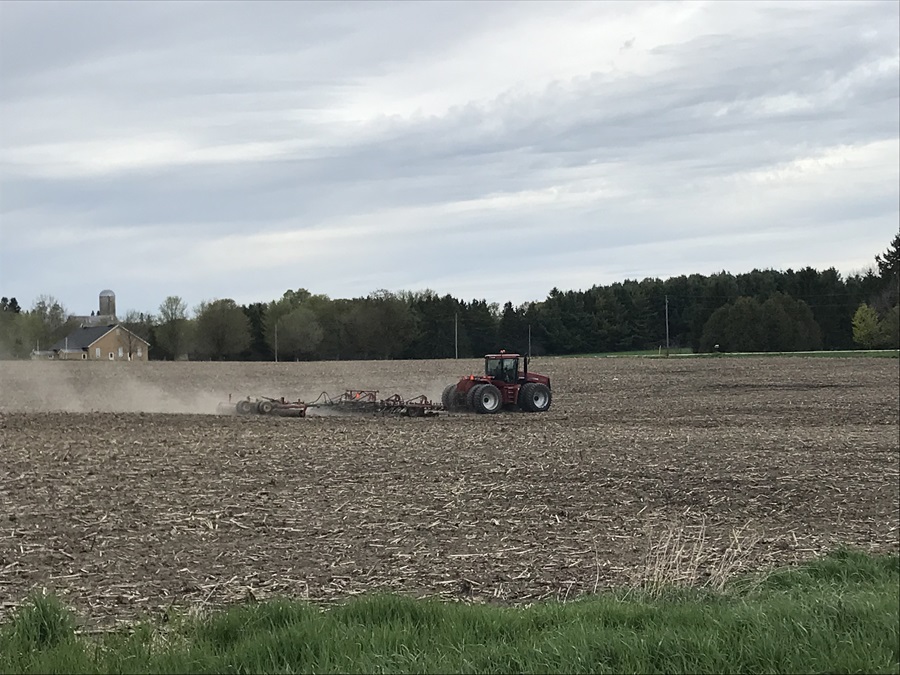
Soybeans
Some soybean planting has begun, roughly 0 to 2 per cent. As soybean planting continues, ensure that the ground is fit before planting; compaction of the soil can cause drainage issues, root growth issues and more. When the planter pulls into the field, ensure that the seed is being planted at an adequate depth, aiming for 1.5” or to soil moisture (up to 2.5” deep in dry soil); depth might vary depending on soil type. Ensure that the planter is set with the correct seeding rate and, if no-till planting, that the previous crop’s residue is being managed properly.
The increase in both daytime and nighttime temperatures will drive corn heat unit accumulation, resulting in rapid plant growth (both weeds and crops). Burndown herbicide applications will now see faster-acting herbicidal activity as plants develop quicker as temperatures rise. Some weeds, such as winter annuals, have grown rapidly during the past few weeks. Canada fleabane has already progressed and is ready to bolt with these warm temperatures. Be timely with burndown applications, as bigger weeds are harder to control and may need additional measures for effective control.
Cereals
Winter wheat in Ontario is around the second node (GS31-32) up to boot stage (GS45, boot just visibly swollen) in the deep southwest. Staging in the deep southwest is 10 to 14 days ahead of “normal”, and it drops down to about one week ahead moving further north and east. Keep an eye out when scouting for sulphur (patches of yellow plants that can also be stunted, thin and may show delayed maturity) and manganese (chlorotic spots and steaks which turn whitish to brown, symptoms appear on younger and central leaves) deficiencies. At this point, both deficiencies can be corrected if identified and action taken.
Herbicide applications need to cease by flag leaf so as not to cause head injury. If spraying is done in cool conditions, many have focused on only using one product in the tank to prevent wheat injury. Second applications of nitrogen have been applied, especially where flag leaves are starting to emerge. Burn to flag leaf from a fungicide/herbicide application can impact yield, so use caution when applying in cold weather. Be sure to speak with your agronomist to determine which herbicides are easier on wheat if temperatures dip toward zero.
There is still time for those aiming to plant spring cereals. Fields that have been planted are emerging. Keep in mind that Agricorp planting deadlines are coming up for spring cereals.

Be Drift Aware
Spray season is here, and there’s a great new resource hub for a refresher or reminder about best practices to reduce spray drift. Visit www.BeDriftAware.ca for practical tips and test your spray smarts with a quick quiz.
May 2, 2024
April showers bring May flowers – well, at this point of the year, there should be a good crop of flowers in the coming month. Rains have been variable across the province; however, there has still been enough rain to keep many farmers and their equipment parked. Winter wheat is still rapidly moving through growth stages depending on the region of the province. Warm weather and sunny skies in the future will see planters rolling.
Corn and soybeans
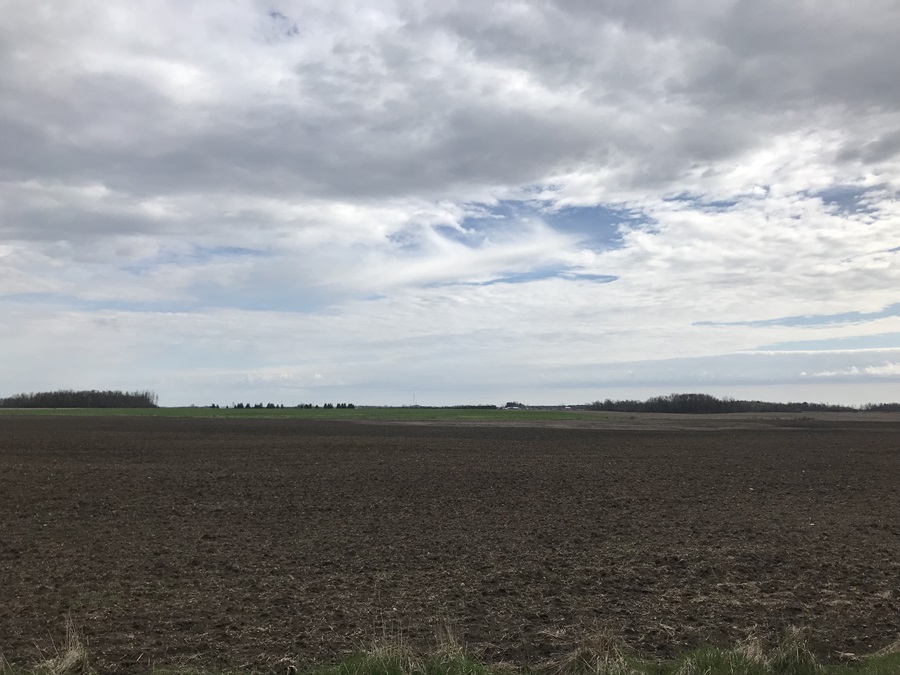
It is important to note that it is still early in the spring season. A few fields of corn have been planted where soil conditions have allowed. Once things dry up, there will be a push to get corn planted. There has been some groundwork in preparation for planting, and manure application has been the priority in livestock areas.
As conditions dry up, ensure that fieldwork and planting aren’t being “rushed.” Ensure that ground conditions are fit for planting. Seedbeds that are too wet when planting occurs can cause emergence issues, root growth issues and, in turn, yield losses.
A key thing to remember when planting corn is weed management. Corn can lose 1 to 3.5 bu per ac per day when weeds are present due to competition for resources and structural changes of the plant. Targeting weeds at emergence and when they are small using multiple modes of action are important keys to management.
Similarly, weed control is crucial for soybeans, especially with IP soybeans; do not let weeds get too large before controlling. Plan to start clean and stay clean, so that yield is not impacted by competition from weeds.
With warmer temperatures, insects are also becoming more active, in some cases much earlier than normal. Be on the lookout for true armyworm and black cutworm, wireworms, and bean leaf beetle (in southern Ontario, bean leaf beetle are out 2-3 weeks earlier than normal – if planting early, make sure the soybean seed is insecticide-treated, and be prepared to scout), and more. Good soil temperatures help plants emerge quickly, with less chance of insect feeding on seeds. The Pest Manager app is an excellent source of information on all pests. Grain Farmers of Ontario supports much of the research that is used in the app. It applies to pests, weeds, and diseases and is updated regularly based on current research data.
As planting ramps up, remember to stay safe.
Cereals

Some spring cereals have been planted, but wet conditions have limited current planting progress. As soon as ground conditions become fit, there will be a push to plant. Remember to check seed sizing and adjust the rate as needed.
Some winter wheat fields have received their second pass of N (or in some cases, a one pass for the year of N), along with a herbicide and T1 fungicide as required. It is incredible how advanced some fields are for this time of the year; it is anticipated that some early planted wheat fields (those planted in September in the southwest) will be creeping quickly towards GS 37 (flag leaf emergence), which means that early planted wheat in the warmer zones could be heading out in mid-May (in roughly two weeks).
Late planted wheat is staging where one might think is “normal” for this time of the year, roughly GS 31 (fist node).
Some winter wheat fields are seeing some winter annual weed pressure, with very advanced weeds in size and maturity. In these situations, fall weed control would have been a great option to keep the winter annuals under control.,.
Waterhemp
A very troublesome weed that many don’t realize has shown multiple forms of resistance across the province is waterhemp. This weed can germinate and emerge throughout the growing season and has high seed production. Waterhemp can be controlled By implementing a two-pass herbicide program using residual herbicides with multiple modes of effective action. Proper identification is key. Once identified, proper equipment cleaning before moving from contaminated fields is highly encouraged to reduce the spread.
Once harvest is complete, plant a cover crop. Cover crops will inhibit waterhemp emergence, growth and seed production. Grain Farmers of Ontario has created an Agronomy Alert on Waterhemp, which includes identification, locations of resistance and how-to programs for control of waterhemp.
More information on waterhemp biology, identification, and control.
Avian Influenza
The Avian Influenza (AI) virus can survive for extended periods of time in the environment, particularly in cooler weather. Here are some important reminders as shared by the Certified Crop Advisor Association. It is important to realize that tilling and planting equipment will cover fields that may have been contaminated by wild birds. Water, wet soil and feces can become contaminated with AI and linger after the migrating flock has moved on. Soil and wild bird feces can stick to tires and undercarriages of vehicles, including field equipment and all-terrain vehicles (ATVs), and be easily spread to other locations.
Follow these guidelines to help mitigate the risk of spreading the virus:
- Wash vehicles between livestock and poultry farms, paying close attention to the vehicle tires and wheel wells.
- For footwear, remove obvious mud and organic matter first and then scrub boots, especially the bottom tread, with a brush and hose. Ensure adequate contact time and concentrations for commercial disinfectants – be sure to read and follow the label!
- Clean all equipment used on the farm that could become contaminated.
- Planting and tilling equipment should be kept away from poultry and livestock barns and from driveways servicing poultry and livestock premises. Avoid contaminating ground areas near barns housing animals.
- Avoid driving near barns that contain animals if possible. If not, drive slowly to minimize dust.
- Avoid parking by exhaust fans and air inlets unless required as part of loading or unloading.
- If there is a visitor log book at the farm, sign it. If there is no log book, keep your own records identifying where you have been and when.
- Leave a note in a mailbox or parcel drop box to let the farm owner or manager know you were there.
- Before getting into your vehicle after a farm call, check to ensure your footwear is clean of organic material.
April 25, 2024
Many farmers are chomping at the bit and ready for spring planting, as April has been a cool, wet month. Fortunately, the long-range forecast does look promising, with warmer, dryer conditions that should see dust start to fly as planters hit the fields. The winter wheat crop is progressing well, especially with some warm weather.
Corn
As planting time approaches, the question comes up: when should planting actually begin? A key to establishing the crop’s potential is to plant it into a seedbed that can provide even and timely emergence. Most importantly, the soil needs to be fit (not too wet, not compacted, or lumpy) before planting for ideal emergence. The ideal soil temperature for planting corn is 10 °C to achieve uniform germination and reduce seedling stress, resulting in corkscrewing and leafing out under the surface. When placed in the soil, the seed will absorb about 30 percent of its weight in water, and the temperature does not affect water imbibition much. However, this differs from radicle (root) and coleoptile (shoot) growth; their growth is correlated with soil temperature. In cold soil conditions (below 10 °C), seeds will readily absorb water but not initiate root or shoot growth, leading to seed rots and poor emergence. Recommendations are to begin planting when soil is near 10 °C, or the forecast is favourable and trending warm. Some have experienced cold conditions after planting the last few years, and colder fields, like no-till fields, experienced lower populations due to cold stress, resulting in leafing out underground. Techniques to warm the soil or waiting until soils warm up will help establish better stand establishment with uniformity. Being aware of soil fitness and temperature helps ensure that plants will be off to a good start this spring.
The inaugural 2023 Ontario corn hybrid DON screening trial report provides a risk assessment of hybrids entered in the 2023 trials, along with a multi‐year assessment on the same hybrids if data were available. To learn how susceptible a hybrid may be, view the report at GoCrops.ca. Hybrids that have statistically higher DON compared to the susceptible check hybrid should be managed appropriately through the season. For more information on DON in general, view the Grain Farmers of Ontario DON in Corn Factsheet.
Soybeans
It is imperative to know soybean seed germination. As soybean planting edges closer and farmers are finalizing planting plans, something to consider is final plant stand goals and what planting population is needed to achieve that. Seed germination is one part of the calculation, as are planting conditions and weather after planting.
Due to poorer fall harvest conditions last fall, some soybean seed this spring may not be at the germination rate experienced in previous years. It would be wise to know the germination rate before planting so seeding rates can be adjusted. For example, if desiring a 150,000 plant stand, the planter will need to drop 187,500 if the germination rate is 80%. Also, adjust the rate based on seedbed conditions or if there are other concerns for emergence, like crusting, etc.
Seed tagged with Canada Certified No. 1 seed tag will have an 85% germination or greater. Canada Certified No. 2 seed will have 75% germination of greater. Note: some companies may have greater internal tolerances and this decides which seed lots to sell. Of course, everyone wants to sell the best quality, but conditions in the previous harvest may affect germination rates in different seed lots. A seed germination test is the best way of knowing, so asking about the germination rate of your seed provider or getting a test done before planting will provide you with the knowledge needed to adjust seeding rates.
Schedule 1 to the Seeds Regulations Grade Table 5 for Soybeans and Corn.

Winter wheat
Winter wheat is rapidly advancing with the warm weather, staging at GS 24 to GS 32, for some, wheat is at or near the second application of Nitrogen, along with a herbicide, a T1 fungicide, and if warranted a PGR (plant growth regulator). As wheat plants approach growth stage 30 (stem elongation) it is the last stage that some herbicides can be used without risk of injury.
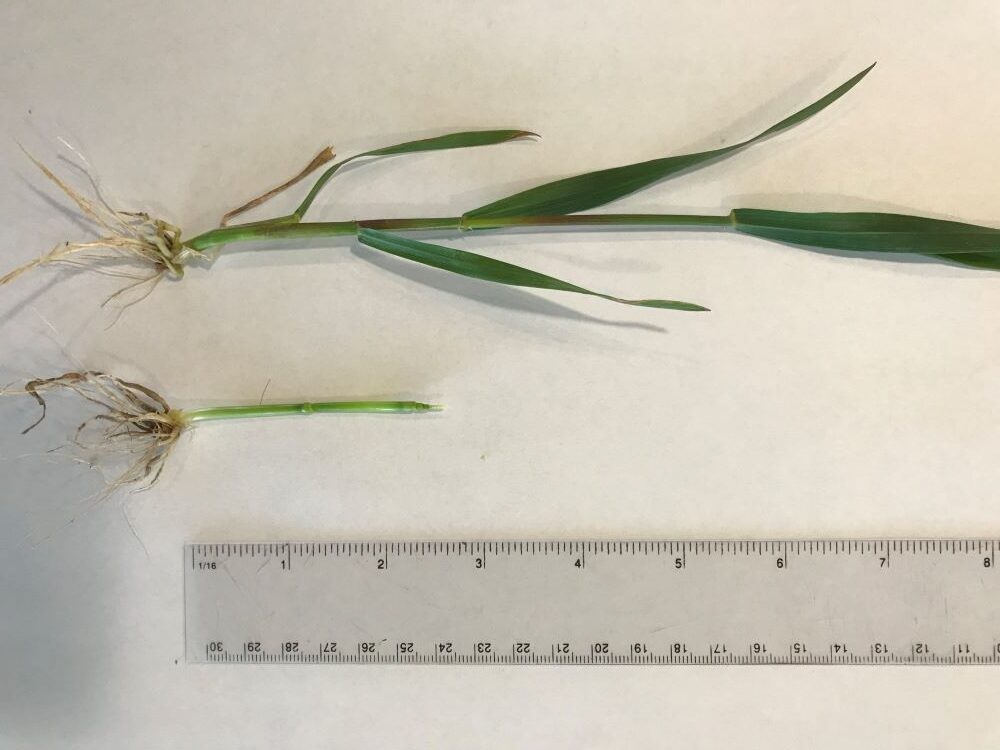
GS 31-37 can be very challenging stages to identify. Use a knife to split the main stem and count the number of nodes separated by the internode. GS 31 will have 1 node detectable, the first node detectable must be above an internode of at least 1 cm, while the second and so on nodes detectable must be above an internode of at least 2cm.
Weather in the past week, across most of the province, has not allowed spraying due to temperatures being too low, which could cause injury to the wheat crop. However, long-range temperatures look favourable. The challenge now will be to travel across the field without creating too much compaction on waterlogged soils.
April 18, 2024
Spring has sprung across the province, with wheat greening up and farmers readying planters and other equipment for a busy spring season. Last week, rains were seen across parts of the province, saturating fields, but with a few warm, sunny days, fields will start to dry up as we move closer to #plant24.
Wheat
Scouting to keep or terminate a wheat field has been ongoing in various areas. Some fields are looking quite good, others are struggling. This Field Crop News article gives a quick lesson on assessing wheat stands.
Fields across the province are staging between growth stage (GS) 24 (4 tillers) to GS 31 (stem elongation), depending on planting dates and crop conditions. There has been some talk of early nitrogen being applied on winter wheat as soils warmed and dried up. For those late-planted fields that need some help tillering this spring, putting a first application of nitrogen on early, at green up, will help plants tiller and improve yield potential. There have been questions on the amount of nitrogen lost through denitrification due to past rains occurring and future rains to come; there are a lot of variables at play with this question: soil type, nitrogen source, and amount of rain all come into play.

A later nitrogen application will be needed to help finish the crop. Fields that are further along in the growth stage will be looking towards herbicide, fungicide and potentially plant growth regulator timing. Be sure to pay close attention to temperatures; avoid temperatures below 5 °C the day before and after spraying for herbicide applications.
Fields planted early last fall tillered nicely before winter and are well established this spring. However, many fields were planted later than many would have liked. It is important to walk fields to check the growth stage of the crop. As scouting occurs, keep an eye out also for powdery mildew, as it thrives in mild winters.
A delay in nitrogen application can result in the crop showing signs of deficiency. The yellowing of wheat due to a lack of nitrogen in the soil is a sign of crop stress. Early stress on the crop will cause fewer florets to develop, which means fewer kernels and a lower yield at harvest. Some of the yellowing this year in wheat might also be due to wet roots; if this is the case over tile runs will be greener than not over tile runs.
It is also important to note herbicide requirements that many need to occur before stem elongation to prevent plant and head development damage. Any stress just before and during stem elongation can cause damage to the developing head and reduce the yield potential. Scout early and scout often for plant growth, weeds, and diseases.
Following the wheat crop along and timing crop protection and nutrient applications is important for optimizing yield. A Visual Guide to Winter Wheat Staging is a handy tool for identifying the growth stage of your crop!
Insects
As planting approaches, insect pests should be monitored as they may affect crop stands. In some cases, insect larvae can cause significant reductions in stands and early-season plant vigour. High-risk fields would be those that are being planted early, following hay or grass, fallow, or a grassy cover crop. Should the spring continue to be wet, it will be favourable to early-season pests. Learn more in this Field Crop News article, Cool wet spring favour early season pets.
Avian Influenza
Avian Influenza has been in the news as it travels across the U.S. As migratory birds travel into Ontario, it is important to keep biosecurity in mind when travelling from field to field. Ensuring you don’t step in bird droppings and staying away from poultry barns is critical, and thoroughly cleaning your boots and field implements when moving from field to field is always good practice. Field Crop News has some practical tips for biosecurity when moving machinery and walking fields.
























